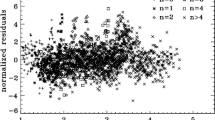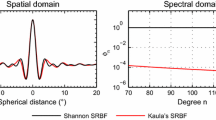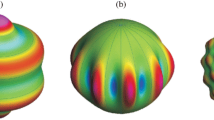Abstract
A spherical harmonic model complete to degree and order seventy has been developed from Doppler tracking of the Lunar Orbiters, the Apollo 15 and 16 subsatellites, and the Clementine spacecraft. The model combines 361,000 observations from Clementine with 347,000 historical observations. The model was developed using the method of Lerch [1991] in order to derive a more realistic realization of the uncertainties associated with this model. An a priori power law of the form 15 × 10−5/12, where l is the spherical harmonic degree, was applied in this model. The Clementine data provide a powerful constraint on the low degree harmonics, and the sectoral terms through degree twenty, by virtue of the spacecraft orbit geometry, and the excellent quality of the tracking data. The gravity anomalies in our model, GLGM-2 (Goddard Lunar Gravity Model-2), have a dynamic range of −294 to +358 mGals when evaluated on the lunar surface at a reference radius of 1738 km. The error predicted from the GLGM-2 covariance ranges from 14 mGals on the equatorial near side to 44 mGals over the high latitude regions of the lunar far side. The model resolves the mascon basins first deduced from Lunar Orbiter tracking [Muller and Sjogren,1968]. Mare Orientale is resolved as a horseshoe-shaped low with an amplitude of −225 mGals centered on the inner and outer Rook rings. Although direct tracking is not available over substantial regions of the lunar farside, the model still resolves far side basins such as South-Pole Aitken, Hertzsprung, Korolev, Moscoviens, and Tsiolkovsky.
Preview
Unable to display preview. Download preview PDF.
Similar content being viewed by others
References
Ananda, M. P. (1977). Lunar gravity: a mass point model, J. Geophys. Res., 82 (20), 3040–3064.
Bills, B. G., and A. J. Ferrari (1980). A harmonic analysis of lunar gravity, J. Geophys. Res., 85 (B2), 1013–1025.
Bryant W. C. Jr., and R. G. Williamson (August 5–9, 1974 ). Lunar gravity analysis results from Explorer 49, AIAA Paper 74–810, AIAA Mechanics and Control of Flight Conference, Anaheim, California.
Chicarro, A., G. Raca, and M. Coradini (1994). MORO: A European Moon-Orbiting Observatory for Global Lunar Characterization, ESA Journal, 18, 183–195
Davies, M. E., et al. (1992). Report of the IAU/IAG/COSPAR working group on cartographic coordinates and rotational elements of the planets and satellites: 1991, Celestial Mechanics, 53, 377–397.
Dickey, J. O. et al. (1994). Lunar laser ranging: a continuing legacy of the Apollo program, Science, 265, 482–490.
Ferrari, A. J. (1977). Lunar gravity: A harmonic analysis, J. Geophys„ Res., 82 (20), 3065–3084.
Folkner, W. M. (1993). Station locations for the Mars Observer encounter version of ODP, JPL Interoffice memorandum, document IOM 335.1–93–013.
IERS Annual Report (1994). International Earth Rotation Service, Central Bureau of the IERS, ed. M. Feissel and N. Essaifi, Observatoire de Paris, Paris, France.
Kaula, W. M. (1966). Theory of Satellite Geodesy, Blaisdell, Waltham, Mass.
Konopliv A. S., W. L. Sjogren, R. N. Wimberly, R. A. Cook, and A. Vijayaraghavan, (Aug. 16–19, 1993 ). A high resolution lunar gravity field and predicted orbit behavior, AAS Paper 93–622, AAS/AIAA Astrodynamics Conference, Victoria, B. C.
Lemoine, F. G., D. E. Smith, M. T. Zuber, G. A. Neumann, and D. D. Rowlands, (1995). GLGM-2: A 70th degree and order lunar gravity model form Clementine and historical data, J. Geophys. Res., submitted.
Lerch, F. J. (1991). Optimum data weighting and error calibration for estimation of gravitational parameters, Bullet. Geod., 65, 44–52.
Liu, A. S., and P. S. Laing (1971). Lunar gravity analysis from long term effects, Science, 173, 1017–1020.
Michael, W. H. and W. T. Blackshear (1972). Recent results on the mass, gravitational field and moments of inertia of the Moon, Moon, 3, 388–402.
Moyer, T. D. (1971). Mathematical formulation of the double precision orbit determination program (DPODP), JPL Technical Report 32–1527, Jet Propulsion Laboratory, Pasadena, California.
Muller, P. M., and W. L. Sjogren (1968). Mascons: lunar mass concentrations, Science, 161, 680–684.
Nozette, S., et al. (1994). The Clementine mission to the Moon: scientific overview, Science, 266, 1835–1839.
Pavlis, D., D. Moore, S. Rowton, S. Luo, J. McCarthy, and S. B. Luthcke (1995). GEODYN operations manuals, five volumes, Hughes/STX Contractor report.
Sjogren, W. L., P. Gottlieb, and P. M. Muller (1972). Lunar gravity via Apollo 14 Doppler radio tracking, Science, 175, 165–168.
Sjogren, W. L., R. N. Wimberly, and W. R. Wollenhaupt (1974a). Lunar gravity via the Apollo 15 and 16 subsatellites, The Moon, 9, 115–128.
Sjogren, W. L., R. N. Wimberly, and W. R. Wollenhaupt (1974b). Lunar gravity: Apollo 16, The Moon, 11, 35–40.
Sjogren, W. L., R. N. Wimberly, and W. R. Wollenaupt (1974c). Lunar gravity: Apollo 17, The Moon, 11, 41–52.
Standish, E. M. Jr. (1990). The observational basis for JPL’s DE200: the planetary ephemeris of the astronomical almanac, Astron. Astrophys., 233, 252–271.
Ullman, R. E. (1994). SOLVE Program: Mathematical formulation and guide to user input, Hughes/STX contractor report, contract NAS5–31760.
Williams, J. G., X. X. Newhall, and J. O. Dickey (1987). Proc. Int. Symp. Figure and Dynamics of the Earth, Moon, and Planets, ed. P. Holota, 643–648, GKP, Prague.
Wong, L., G. Buechler, W. Downs, W. L. Sjogren, P. M. Muller, and P. Gottlieb (1971). A surface layer representation of the lunar gravity field, J. Geophys. Res., 76, 6220–6236.
Zuber, M. T., D. E. Smith, F. G. Lemoine, and G. A. Neumann (1994). The shape and internal structure of the Moon from the Clementine mission, Science, 266, 1839–1843.
Author information
Authors and Affiliations
Editor information
Editors and Affiliations
Rights and permissions
Copyright information
© 1996 Springer-Verlag Berlin Heidelberg
About this paper
Cite this paper
Lemoine, F.G., Smith, D.E., Zuber, M.T., Neumann, G.A. (1996). High Degree and Order Spherical Harmonic Models for the Moon From Clementine and Historic S-Band Data. In: Rapp, R.H., Cazenave, A.A., Nerem, R.S. (eds) Global Gravity Field and Its Temporal Variations. International Association of Geodesy Symposia, vol 116. Springer, Berlin, Heidelberg. https://doi.org/10.1007/978-3-642-61140-7_18
Download citation
DOI: https://doi.org/10.1007/978-3-642-61140-7_18
Publisher Name: Springer, Berlin, Heidelberg
Print ISBN: 978-3-540-60882-0
Online ISBN: 978-3-642-61140-7
eBook Packages: Springer Book Archive




